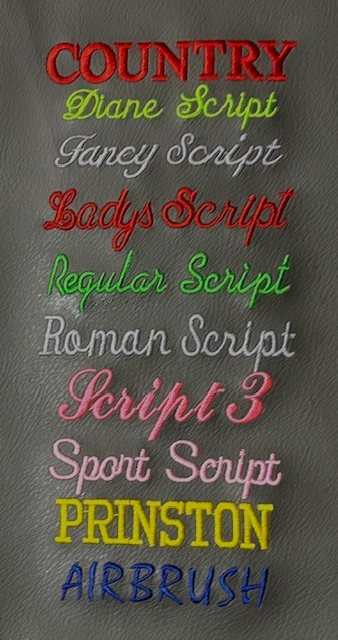The Art of Personalized Embroidery: Unlocking the Keys to Creating Special and Unforgettable Styles
Embroidery, a craft steeped in custom and virtuosity, holds within its elaborate stitches the power to change material into a canvas of unique expression. The keys to developing custom embroidery designs that captivate the eye and leave an enduring perception depend on a fragile equilibrium of method, creativity, and interest to detail. As we explore the world of custom-made embroidery, we discover the nuanced interaction between thread choice, sew complexity, and layout customization that raises a plain garment to an artwork. Join us on a journey through the art of custom-made embroidery as we decipher the secrets behind crafting absolutely unforgettable and distinct developments.
Selecting the Right Embroidery Threads
When picking embroidery threads, what key elements should you take into consideration to guarantee the finest results for your personalized designs? The choice of embroidery thread is vital in identifying the last end result of your stitched style.
Thicker strings can include measurement and texture to your design, while finer threads are perfect for elaborate details and tiny message. In addition, taking into consideration the color fastness and washability of the thread is crucial to ensure that your personalized layouts keep their top quality and vibrancy over time.
Discovering Various Stitch Techniques
To explore the world of 'Exploring Different Stitch Strategies', one need to realize the complexities and nuances that each sewing method gives the art of embroidery. Various stitch methods not only add visual interest however additionally add to the general appearance and dimension of the design. One prominent stitch strategy is the satin stitch, which involves closely stuffed parallel stitches to develop a smooth and shiny surface, ideal for filling in forms and producing vibrant outlines.
On the various other hand, the backstitch is a versatile technique often utilized for describing and adding fine information. It involves stitching backwards to create a strong line of embroidery. Furthermore, the French knot stitch adds a tactile element to designs, perfect for creating textured accents like blossom centers or decorative touches.
Discovering different stitch techniques permits embroiderers to play with light, shadow, and deepness within their layouts, elevating the visual appeal and artistic high quality of their embroidery projects. By grasping various sewing approaches, one can unlock countless possibilities for creating one-of-a-kind and memorable personalized embroidery items.
Incorporating Personalized Style Aspects
Having actually checked out the complexities of different stitch methods such as the satin stitch, backstitch, and French knot, the emphasis online custom tailoring now changes in the direction of integrating customized layout elements in custom needlework projects. Individualized layout components play a critical role in making needlework jobs absolutely special and remarkable. One method to incorporate personalization is by including initials, names, or considerable days to the style. This not just includes a personalized touch but likewise boosts the emotional value of the needlework piece.
An additional way to incorporate customized design elements is by consisting of symbols or motifs that hold special significance to the recipient or mirror their passions and individuality. For example, integrating a favored flower, pet, or hobby-related symbol can make the embroidery style extra significant and individualized. Furthermore, picking shades that resonate with the recipient or straighten with the intended style can even more boost the personalization of the needlework project.
Grasping the Art of Color Coordination
One secret element of shade coordination is understanding shade concept. This includes recognizing just how various colors interact with each other, the emotions they communicate, and how they can be integrated to create aesthetically appealing layouts. By applying shade theory principles, embroiderers can create harmonious color combinations that improve the general appearance of the layout.
Furthermore, taking note of contrast is crucial in color sychronisation. Utilizing contrasting colors can help certain elements of the layout pop, boost clarity, and create an aesthetically dynamic embroidery piece. By grasping the art of color sychronisation, embroiderers can elevate their layouts and produce memorable pieces that resonate with customers and customers alike.
Enhancing Appearance With Advanced Needlework Stitches

French knots, as an example, are excellent for adding small, increased dots to your style, imitating the look of grains or producing a distinctive surface. Bullion knots, on the other hand, can be made use of to produce twisted, ropelike components that include a glamorous feeling to the needlework. Seed sewing entails small, scattered stitches that can complete areas with a multicolor structure, while turkey article source work creates cosy, dimensional accents similar to animal fur or vegetation. Exploring with these innovative needlework stitches enables you to press the borders of conventional needlework and create genuinely special and reference visually appealing structures in your designs.
Final Thought
To conclude, the art of custom embroidery involves a mix of choosing the right threads, checking out different stitch methods, incorporating tailored design components, mastering color control, and enhancing appearance with advanced stitches. By recognizing and executing these crucial elements, embroiderers can create distinct and remarkable designs that display their creative thinking and ability. Needlework lovers can unlock the secrets to developing attractive and custom pieces that stand out and leave a lasting impression.